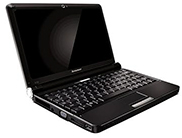This content is 15 years old. I don't routinely update old blog posts as they are only intended to represent a view at a particular point in time. Please be warned that the information here may be out of date.
Yesterday, I wrote about the new NetBook PC that I’ve ordered (a Lenovo IdeaPad S10). In that post I mentioned that I had some concerns about running Windows 7 on a PC with a solid state drive (SSD) and I wanted to clarify something: it’s not that Windows 7 (or any other version of Windows) is inherently bad on SSD, it’s just that there are considerations to take into account when making sure that you get the most out of a solid state drive.
Reading around various forums it’s apparent that SSDs vary tremendously in quality and performance. As a consequence, buying a cheap NetBook with a Linux distro on it and upgrading the SSD to a larger device (the Linux models generally ship with lower capacity SSDs than their more expensive Windows XP brethren) is not necessarily straightforward. Then there’s the issue of form factor – not all SSDs use the same size board.
Another commonly reported issue is that NTFS performance on an SSD is terrible and that FAT32 should be used instead. That rings alarm bells with me because FAT32: does not include any file-level access control lists; has a maximum file size of 4GB (so no good for storing DVD ISOs – not that you’ll get many of those on the current generation of SSDs – anyway, most NetBooks do not ship with an optical drive).
The reason for poor NTFS performance on SSDs may be found in a slide deck from the 2008 Windows Hardware Engineering Conference (WinHEC), where Frank Shu, a Senior Program Manager at Microsoft, highlights:
- The alignment of NTFS partition to SSD geometry is important for SSD performance in [Windows]
- The first Windows XP partition starts at sector #63; the middle of [an] SSD page.
- [A] misaligned partition can degrade [the] device’s performance […] to 50% caused by read-modify-write.
It sounds to me as if those who are experiencing poor performance on otherwise good SSDs (whilst SSDs come in a smaller package, are resistant to shocks and vibration, use less power and generate less heat than mechanical hard drives SSD life and performance varies wildly) may have an issue with the partition alignment on their drives. Windows 7 implements some technologies to make best use of SSD technology (read more about how Windows 7 will, and won’t, work better with SSDs in Eric Lai’s article on the subject).
In addition, at the 2007 WinHEC, Frank Shu presented three common issues with SSDs:
- Longer setup time for command execution.
- SSD write performance.
- Limited write cycles for NAND flash memory (100,000 write cycles for single layer cell devices and 10,000 write cycles for multi layer cell devices).
(He also mentioned cost – although this is dropping as SSDs become more prevalent in NetBooks and other PC devices aimed at highly-mobile users).
In short, SSD technology is still very new and there are a lot of factors to consider (I’ve just scraped the surface here). I’m sure that in the coming years I’ll be putting SSDs in my PCs but, as things stand at the end of 2008, it’s a little too soon to make that jump – even for a geek like me.
Incidentally, Frank Shu’s slide decks on Solid State Drives – Next Generation Storage (WinHEC 2007: WNS-T432) and Windows 7 Enhancements for Solid-State Drives (WinHEC 2008: COR-T558) are both available on the ‘net and worth a look for anyone considering running Windows on a system with an SSD installed.
 I’ve been watching developments with small form-factor PCs (so called “NetBooks”) for a while now and over the weekend I took the plunge. Tomorrow morning I’m expecting a delivery of a Lenovo IdeaPad S10 to slip in my bag alongside the Fujitsu-Siemens S7210 that I use for work.
I’ve been watching developments with small form-factor PCs (so called “NetBooks”) for a while now and over the weekend I took the plunge. Tomorrow morning I’m expecting a delivery of a Lenovo IdeaPad S10 to slip in my bag alongside the Fujitsu-Siemens S7210 that I use for work.